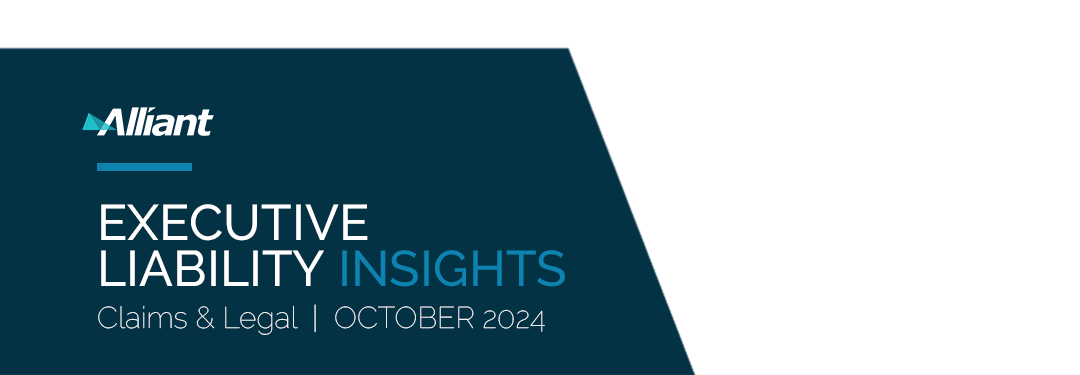
SECURITIES CORNER
SEC COMMISSIONERS CALL FOR MORE GUIDANCE ON RECORDKEEPING RULES


In recent years, the SEC has cracked down on financial firms and collected billions in civil fines for these firms’ recordkeeping failures regarding the use of off-channel communications to conduct business. Current recordkeeping rules have caused conflict within the SEC itself, with two commissioners calling for updated rules to match technological developments, more guidance for rule compliance, and less aggressive civil penalties.
Speaking of penalties, the last issue of Executive Liability Insights elaborated on how failure to comply with the SEC’s rules on off-channel communications costed $390 M in penalties to twenty-six broker dealers, investment advisers, and dually registered broker dealers and investment advisers firms.
Critics of the current rules argue that firms do not have a clear or achievable path to compliance, with the most well-intentioned employees in danger of potential violations. The rules require firms to be in perfect compliance, which is not practicable and leading to over enforcement.
The shortcoming of the current rules is that the SEC failed to take into consideration human error as well as the modern communication avenues when creating and enforcing these recordkeeping rules. In June’s issue of Executive Liability Insights, Alliant has expanded on how realities of modern work life, such as remote work and developing technology, contribute to the off-channel communications violations even in instances when such communications were not initiated by the employees of a given firm. Unfortunately, the SEC’s approach or the policy is unlikely to change anytime soon as any potential updates and clarifications to the rules could take years to be implemented. Therefore, businesses continue to be responsible for developing expansive and clear policies surrounding off-channel communications. Attorneys argue that in the meantime, the SEC could offer some guidance on what is currently expected from firms and help clear up some of the ambiguity regarding the implementation of recordkeeping rules for employees’ use of off-channel communications.


In a recent report released by Cornerstone Research, it was revealed that nearly half of the securities class actions settled between 2019 and 2023 were associated with a parallel (“follow-on”) derivative claim that featured the same or similar underlying allegations. Additionally, nearly half of all federal derivative filings between this time were filed in either the District of Delaware, Southern District of New York, or Northern District of California.
In 2023, 92% of the settlements included a therapeutic provision (corporate governance reforms to deter future misconduct), while only 26% included a monetary component. Securities class actions with a follow-on derivative claim were typically associated with higher settlements ($14.5 million) than those without a follow-on derivative claim. The report further noted that derivative settlements with a monetary component were associated with higher securities class action settlements, maintaining the view that the monetary settlements correlated with the size or the strength of the underlying allegations. Such derivative claims had a median settlement of $8.9 million. Derivative settlements with a monetary component were more likely associated with an SEC action or criminal charges against the defendants or related parties in connection with the allegations covered by the underlying class action.
Additionally, attorney fee awards for monetary settlements and derivative settlements showed significant variations in 2023. The median plaintiff attorney fee award associated with the derivative settlements was approximately $800,000, while the median fee with a monetary settlement was $3 million.
Between 2005 and 2023, there were 29 settlements of at least $50 million, 16 of which occurred after 2020. This trend of large derivative settlements may pave the way for other large derivative settlements and/or motivate filings in the coming years. As a result, companies facing securities lawsuits and underwriters writing these policies should be on notice of potential premium increases and exclusions for Directors and Officers coverage.
|
Director/Officer |
Role |
Company |
|
Louis Hernandez, Jr. |
CEO |
Black Dragon Capital, LLC |
|
Marg Patel & Robert Horowitz |
CEO & CFO |
Medly Health Inc. |
|
Charles E. Jones |
Former CEO |
FirstEnergy Corp. |
|
Paul D. Roberts |
CEO & President |
Kubient Inc. |
|
Baba Nadimpalli |
Co-Founder & CEO |
SKAEL Inc. |
|
Christopher Beals & Arden Lee |
Former CEO & Former CFO |
WM Technology, Inc. |
|
Remi Barbier |
Former CEO |
Cassava Sciences, Inc. |
|
Director/Officer |
Role |
Company |
|
Louis Hernandez, Jr. |
CEO |
Black Dragon Capital, LLC |
|
Marg Patel & Robert Horowitz |
CEO & CFO |
Medly Health Inc. |
|
Charles E. Jones |
Former CEO |
FirstEnergy Corp. |
|
Paul D. Roberts |
CEO & President |
Kubient Inc. |
| Baba Nadimapalli | Co-Founder & CEO | SKAEL Inc. |
| Christopher Beals & Arden Lee | Former CEO & Former CFO |
WM Technology, Inc. |
| Remi Barbier | Former CEO | Cassava Sciences, Inc. |
SEPTEMBER 2024 NOTEWORTHY SETTLEMENTS AND JUDGMENTS
|
Amount |
Director/Officer |
Role |
Company |
|
$2,400,000 |
Abraxas DiScala |
CEO & President |
CodeSmart, Inc. |
|
$7,216,801 |
Kris A. Swaffer & Sean K. Williams |
President & COO |
POHIH, Inc. |
|
$499,909 |
Matthias O'Meara |
Officer |
Choice Advisors, LLC |
| $150,000 | Lionel Selwood, Jr. | Former CEO | Romeo Power, Inc. |
| $175,000 | James R. Craigie | Former CEO | Church & Dwight Co. Inc. |
|
Amount |
Director/Officer |
Role |
Company |
|
$2,400,000 |
Abraxas DiScala |
CEO & President |
CodeSmart, Inc. |
|
$7,216,801 |
Kris A. Swaffer & Sean K. Williams |
President & COO |
POHIH, Inc. |
|
$499,909 |
Matthias O'Meara |
Officer |
Choice Advisors, LLC |
|
$150,000 |
Lionel Selwood, Jr. |
Former CEO |
Romeo Power, Inc. |
|
$175,000 |
James R. Craigie |
Former CEO |
Church & Dwight Co. Inc. |
Source: U.S. Securities and Exchange Commission
https://www.sec.gov/litigation/admin.htm